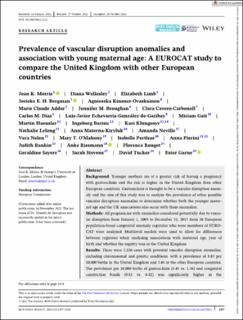| dc.contributor.author | Morris, Joan K. | |
| dc.contributor.author | Wellesley, Diana | |
| dc.contributor.author | Limb, Elizabeth | |
| dc.contributor.author | Bergman, Jorieke E. H. | |
| dc.contributor.author | Kinsner-Ovaskainen, Agnieszka | |
| dc.contributor.author | Addor, Marie Claude | |
| dc.contributor.author | Brougham, Jennifer M. | |
| dc.contributor.author | Cavero-Carbonell, Clara | |
| dc.contributor.author | Dias, Carlos M. | |
| dc.contributor.author | Echevarría-González-de-Garibay, Luis-Javier | |
| dc.contributor.author | Gatt, Miriam | |
| dc.contributor.author | Haeusler, Martin | |
| dc.contributor.author | Barisic, Ingeborg | |
| dc.contributor.author | Klungsøyr, Kari | |
| dc.contributor.author | Lelong, Nathalie | |
| dc.contributor.author | Materna-Kiryluk, Anna | |
| dc.contributor.author | Neville, Amanda | |
| dc.contributor.author | Nelen, Vera | |
| dc.contributor.author | O'Mahony, Mary T. | |
| dc.contributor.author | Perthus, Isabelle | |
| dc.contributor.author | Pierini, Anna | |
| dc.contributor.author | Rankin, Judith | |
| dc.contributor.author | Rissmann, Anke | |
| dc.contributor.author | Rouget, Florence | |
| dc.contributor.author | Sayers, Geraldine | |
| dc.contributor.author | Stevens, Sarah | |
| dc.contributor.author | Tucker, David | |
| dc.contributor.author | Garne, Ester | |
| dc.date.accessioned | 2023-03-01T12:02:08Z | |
| dc.date.available | 2023-03-01T12:02:08Z | |
| dc.date.created | 2022-12-05T12:46:05Z | |
| dc.date.issued | 2022 | |
| dc.identifier.issn | 2472-1727 | |
| dc.identifier.uri | https://hdl.handle.net/11250/3054952 | |
| dc.description.abstract | Background
Younger mothers are at a greater risk of having a pregnancy with gastroschisis and the risk is higher in the United Kingdom than other European countries. Gastroschisis is thought to be a vascular disruption anomaly and the aim of this study was to analyze the prevalence of other possible vascular disruption anomalies to determine whether both the younger maternal age and the UK associations also occur with these anomalies.
Methods
All pregnancies with anomalies considered potentially due to vascular disruption from January 1, 2005 to December 31, 2017 from 26 European population-based congenital anomaly registries who were members of EUROCAT were analyzed. Multilevel models were used to allow for differences between registries when analyzing associations with maternal age, year of birth and whether the registry was in the United Kingdom.
Results
There were 5,220 cases with potential vascular disruption anomalies, excluding chromosomal and genetic conditions, with a prevalence of 8.85 per 10,000 births in the United Kingdom and 5.44 in the other European countries. The prevalence per 10,000 births of gastroschisis (4.45 vs. 1.56) and congenital constriction bands (0.83 vs. 0.42) was significantly higher in the United Kingdom, even after adjusting for maternal age. However, transverse limb reduction defects had a similar prevalence (2.16 vs. 2.14 per 10,000). The expected increased prevalence in younger mothers was observed for vascular disruption anomalies overall and for the individual anomalies: gastroschisis and congenital constriction bands.
Conclusion
Vascular disruption anomalies that had an increased risk for younger mothers (such as gastroschisis) had a higher maternal age standardized prevalence in the United Kingdom, while vascular disruption anomalies with weaker associations with younger mothers (such as transverse limb reduction defects) did not have an increased prevalence in the United Kingdom, which may indicate a different etiology for these anomalies. | en_US |
| dc.language.iso | eng | en_US |
| dc.publisher | Wiley | en_US |
| dc.rights | Navngivelse 4.0 Internasjonal | * |
| dc.rights.uri | http://creativecommons.org/licenses/by/4.0/deed.no | * |
| dc.title | Prevalence of vascular disruption anomalies and association with young maternal age: A EUROCAT study to compare the United Kingdom with other European countries | en_US |
| dc.type | Journal article | en_US |
| dc.type | Peer reviewed | en_US |
| dc.description.version | publishedVersion | en_US |
| dc.rights.holder | Copyright 2022 The Author(s) | en_US |
| cristin.ispublished | true | |
| cristin.fulltext | original | |
| cristin.qualitycode | 1 | |
| dc.identifier.doi | 10.1002/bdr2.2122 | |
| dc.identifier.cristin | 2088729 | |
| dc.source.journal | Birth Defects Research | en_US |
| dc.source.pagenumber | 1417-1426 | en_US |
| dc.identifier.citation | Birth Defects Research. 2022, 114 (20), 1417-1426. | en_US |
| dc.source.volume | 114 | en_US |
| dc.source.issue | 20 | en_US |

